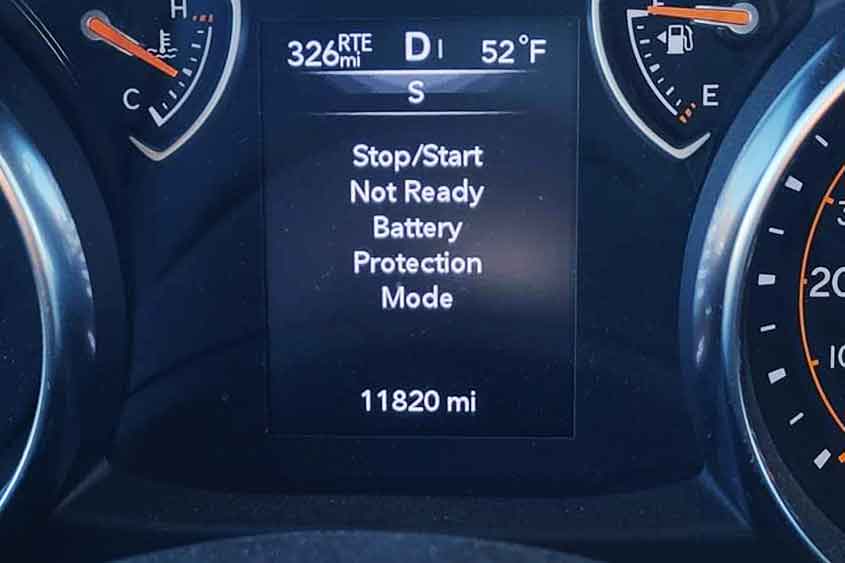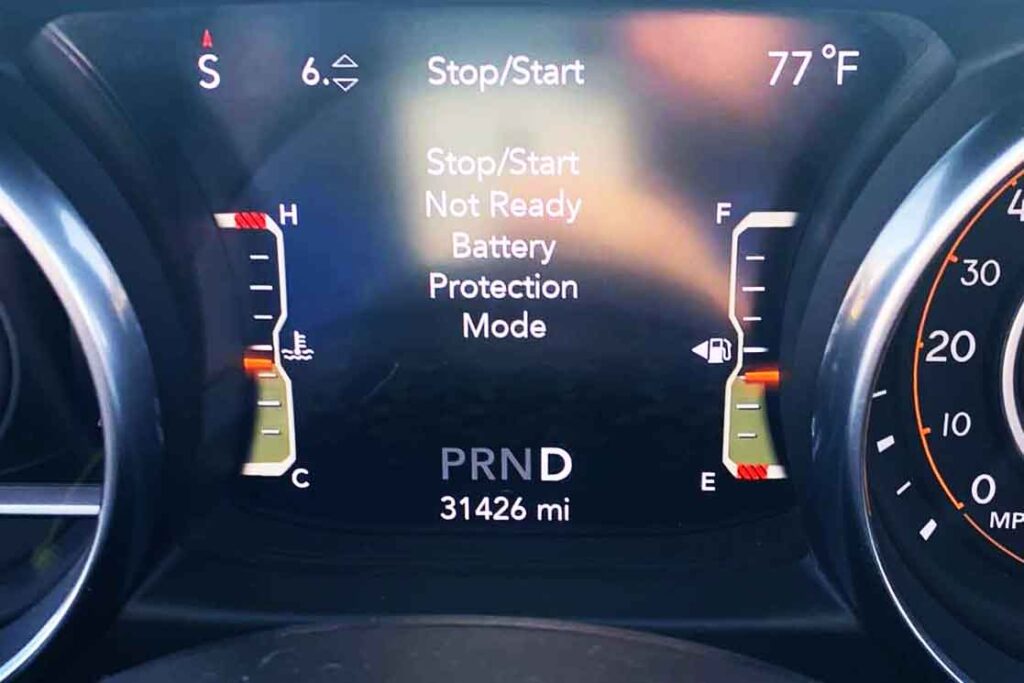Stop Start Not Ready Battery Protection Mode: 12 Tips to Fix the Warning
The stop start system is excellent. But often, it has issues. When specific criteria are not met, the system doesn’t enable it. One of those criteria is a healthy, charging battery. When your battery dies, your stop start system will not work, and you’ll get a “stop start not ready battery protection mode” error on your dashboard. Other issues can cause this, such as low voltage, battery not charging, battery connection issues, blown relay fuse, or your battery charge being drained for reasons like your car sitting in your driveway for a while or the weather freezing. You may find this a significant source of stress. If you’re also anxious about it, this article might help you.
Table of Contents
What is “Stop Start Not Ready Battery Protection Mode”?

According to the message “stop start not ready battery protection mode,” the voltage is too low, and the Jeep attempts to turn off systems that are consuming power. The system turns off if the voltage is less than 10 volts. More Jeep equipment is turned off as voltage drops. The stop/start system will be the first to go. Accessories like the radio, seat, and heat will eventually stop working. The only systems that will keep the Jeep road-legal are the lights, wipers, and other safety-related systems. Even the AC and heat will eventually stop working. The stop start system won’t enable because it ensures everything is in order before doing so, putting less strain on the battery.
Why Does the “Stop Start Not Ready Battery Protection Mode” Warning Appear?
There are several reasons why the “stop/start not ready battery protection mode” warning might appear:
- When one or both of your batteries fail the stop start protocol’s battery test, the stop start not ready battery protection mode appears. Most of the time, your car is in battery protection mode because the voltage of your battery is too low. Battery protection mode will be activated when a battery’s voltage drops below a certain point to prevent the battery from being damaged. An error message stating “stop start not ready battery protection mode” will appear.
- Battery performance is another factor to consider. Older batteries may not hold charge as well. This problem can be brought on by several things, including a weak alternator or an issue with the electrical system. Batteries eventually need to be replaced because they ultimately lose their ability to hold a charge, especially if the battery gets older. The error “stop start not ready battery protection mode” will undoubtedly appear on the screen in that scenario.
- Again, “stop start not ready battery protection mode” is triggered when the system voltage falls extremely low for whatever reason. You might have left the Jeep sitting for a while (over a week). The battery might have discharged completely without being used and gone into protection mode.
- If you don’t drive much, to begin with, and the weather is icy outside, your battery can quickly be depleted, and you may encounter the “stop start not ready battery protection mode” error when starting your Jeep. In that case, the error should go as soon as the weather clears or the car heats up.
- It is not uncommon for problems to arise after replacing a battery. “stop start not ready battery protection mode” is not something we see very often with a new battery. Many new batteries sit on shelves for a while and need a good charge. Also, they can be defective sometimes.
- If you see the evic message, “stop start not ready battery protection mode”, check if you have a blown relay fuse.
- Did you double-check that the battery connectors were securely attached? They are fragile and difficult to fasten tightly. If you or someone else installed felt washers on the posts, I advise removing them because they prevent the connectors from being adequately tightened (since the posts are conical, the connectors must sit all the way down). The error “stop start not ready battery protection mode” can be caused by a loose connection.
- After changing a battery, you might encounter the “stop start not ready battery protection mode” error. Wait for a day or two and drive for a bit. After a battery swap, the IBS re-learns itself, requiring a few engine On/Off cycles over a day or two.
- The auxiliary battery kicks in when the main battery is too weak to start the engine on its own. If your aux battery is weak, low, or dead, and you try to start the car with a fully charged main battery, the “stop start not ready battery protection mode” message may appear. You need to change the aux battery.

How to Solve the “Stop Start Not Ready Battery Protection Mode” Warning?
There are ways you could try to resolve the “stop/start not ready battery protection mode” warning:
- Getting a charger should be your first step. Plan to charge for an entire day if your charger is small. It would be ideal if you could drive to a nearby auto parts shop that provides free battery tests. If you have another vehicle and can drive, you can remove the battery from the Jeep and test it (if you feel comfortable doing so). The battery is the one that can be tested the quickest. Check it out first, then the battery sensor and the alternator.
- Set it up for overnight trickle charging. Give the trickle charger 12 to 16 hours to run continuously. If no battery tender is available, simply go for a long drive with stop start turned off, preferably at highway speeds. That’ll charge both batteries via the PCM and BCM.
- To restart the Jeep after the proper voltage has been restored, turn it off, let it sit briefly, or open a door. Until the voltage drops again, it will reset the system.
- If your Jeep was sitting in the dealership for a while, charge it sufficiently while driving it home, and you won’t have the issue again.
- Sometimes you can resolve the issue by charging the Aux battery properly. But if the AUX is dying or there is a bad relay, what I have encouraged you to do will not be a remedy.
- Only drive for a short time with the AUX battery connected if it appears that your main battery is running low; doing so will also drain it. Unplug the AUX negative terminal until you get a new battery.
- After replacing the batteries, did you perform a battery reset? Detach the negative cable(s), press the brake pedal for 30 seconds, reconnect, and start the engine. If that does not make a difference, check the charging system if you haven’t yet.
- If your battery is currently in its fourth year and dying, replace the battery, or it will deplete your other battery. On both batteries, unplug the negative cable after waiting around five minutes. Reconnect the device and take a 30-minute drive on the highway to recharge the battery. “stop start not ready battery protection mode” message will not return.
- Your battery might have been accidentally heavily discharged; all it needs now is a good/full charge. Additionally, make sure the battery connectors are tightly fastened.
- Remove the cap from the fuse box (power distribution hub) next to the main battery. Now, apply pressure firmly to each fuse and relay inside. There, you’ll discover improperly seated fuses and relays.
- Have your mechanic perform a re-learn procedure on the Jeep if the “stop start not ready battery protection mode” message appears after you’ve changed your batteries. Everything will work out fine.
- A 100% fully charged battery is required for stop-start systems. Check your battery. It may work fine for everything else but may be less than 100%. The stop start system will resume regular operation once the battery is replaced. Factory batteries are typically poor quality and only last 3–4 years, whereas a high-quality aftermarket battery may last up to twice as long.
Make an appointment with your dealership’s service department if, despite the steps mentioned above, the EVIC message persists.
How to Check Your Battery Health?
Before testing the main battery, you must unplug the aux battery’s negative cable. If you don’t do this and the aux battery is still linked to the main battery, both batteries will be tested as if they were one bigger battery. The test is contaminated, thus making it invalid. If your symptoms point to a bad main battery and possibly a bad alternator (which should also be load tested with the engine running), test the battery immediately, as the bad battery will drain the good battery.
Tips for Keeping Your Battery in Good Health
Investing in a battery tender or other regulated trickle charger to keep the battery charged is smart if you don’t drive your Jeep frequently. Some systems are constantly draining voltage, even when the car is off.
Regarding your inquiry about a trickle charger, we recommend the Deltran Tender Plus. Install the quick connect as well. It is an easy hookup, and the connection over the clips is reliable. Simply hook it up if you plan to leave the car parked for three to four days. This is a smart move because most vehicles’ batteries now last longer when a tender is used.
Read More:
- ACC FCW Limited Functionality: 3 Tips to Fix the Warning
- ACC FCW Unavailable Service Required: 15 Tips to Fix the Warning
Conclusion
The best way to avoid problems is to maintain a healthy car battery. Have it checked out frequently, and replace it if necessary. Consider getting a battery backup system to keep your car running in an emergency. These systems can be beneficial in preventing your Jeep from being stranded due to a dead battery.
The “stop start not ready battery protection mode” message on some Jeep models might be a symptom of an issue that prevents the battery from functioning properly. In this case, the battery will continue to power all your vehicle’s systems, but stop start will not be available.
Keep in mind that this message isn’t a significant problem. The vehicle will still start as usual. However, if the message continues to happen often or you are concerned about your charging system’s health, take it out to a professional technician.
